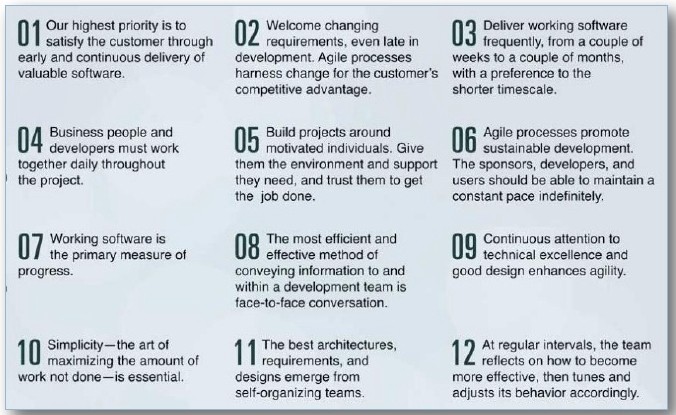
What was before the famous ?Agile Manifesto?? It is rather difficult to imagine but there were many software solutions that had been born before it.
Before the ?Manifesto,? software development was not so fast. Many projects in the pipeline were canceled due to changing business needs. The software development industry was prime for disruption. 12 principles of Agile software sought to change things, speed up development time, and a produce a quality.
The Agile Manifesto is the base of the Agile transformation movement. Here I briefly describe the four values and twelve principles that lead to higher-quality software delivered to satisfied customers on a continuous basis.
What are the roots?
As any framework or methodology, Agile also has its own history. In the 1990s, several methodologies with a different combination of different old and new ideas began to gain public attention.
The methodologies highlighted close collaboration between business stakeholders and developments and meant the frequent delivery of business value and self-organizing teams.
?Agile? as the term was applied to this set of methodologies in 2001.
It was the collaboration of 17 software developers who gathered in Utah, USA, to discuss their ideas and different approaches to software development. Their smart thoughts were expressed in the famous Agile Manifesto that included 12 principles.
The Agile Manifesto consists of 4 foundational values and 12 supporting principles that lead the Agile approach to software development.
Each Agile methodology applies the 4 values in different ways. However, all of them rely on these values to guide the development and delivery of high-quality, working software.
4 values of the Agile Manifesto
1. Individuals and interactions over processes and tools
The value #1 in the Agile Manifesto is known as ?Individuals and interactions over processes and tools.? It?s crucial to value people more highly than processes or tools. It is the people who respond to business needs and drive the development process. When the development is driven by the process or tools, then the team is less responsive to changes and less likely to meet customer needs.
2. Software over documentation
Historically, documenting the product for development and ultimate delivery required enormous amounts of time. Technical requirements, specifications, prospectus, testing plans, interface design documents, and different approvals were required for each. There were long delays in development.
Agile streamlines documentation, not eliminating it. In this form, it gives developers what they need to do without getting bogged down in minutiae. Agile values documentation, but it values working software more.
3. Customer collaboration over contract negotiation
Negotiations are important. It?s about the period when customers and a product manager work out the details of a delivery with all the details. However, collaboration is a different creature entirely and it really matters.
According to Waterfall, customers negotiate the requirements for the product, often in great detail, prior to any work starting. The Agile Manifesto describes a customer who collaborates throughout the development process, making. It?s easier for development to meet their needs of the customer.
According to Agile methods, the customer may be included at intervals for periodic demos, but a project could just as easily have an end-user as a daily part of the team.
4. Responding to changes over following a plan
Traditional software development regarded change as an expense. It was to be avoided.
According to Agile, the shortness of an iteration means priorities can be shifted from iteration to iteration and new features can be added into the next iteration. Changes always improve a project and provide additional value.
12 principles of Agile development
These principles can be your litmus test to define whether or not you?re being Agile. So, always remember them in a short form:
- Our highest priority is to satisfy the customer through early and continuous delivery of valuable software.
- Welcome changing requirements, even late in development. Agile processes harness change for the customer?s competitive advantage.
- Deliver working software frequently, from a couple of weeks to a couple of months, with a preference to the shorter timescale.
- Business people and developers must work together daily throughout the project.
- Build projects around motivated individuals. Give them the environment and support they need, and trust them to get the job done.
- The most efficient and effective method of conveying information to and within a development team is face-to-face conversation.
- Working software is the primary measure of progress.
- Agile processes promote sustainable development. The sponsors, developers, and users should be able to maintain a constant pace indefinitely.
- Continuous attention to technical excellence and good design enhances agility.
- Simplicity ? the art of maximizing the amount of work not done ? is essential.
- The best architectures, requirements, and designs emerge from self-organizing teams.
- At regular intervals, the team reflects on how to become more effective, then tunes and adjusts its behavior accordingly.

Use appropriate project management tools to get started with Agile
Hygger is a powerful task and project management tool with collaboration features that are crucial for Agile project management. With its help, you can make real-time updates and alert your team about the new changes, share your plans with internal and external stakeholders to increase transparency and keep everyone on the same page.
The following tutorials will be helpful if you decide to rub your projects with Hygger:
- How to do Kanban with Hygger Software?
- How to Do Scrum with Hygger Software?


